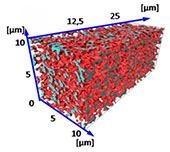Research and development in highest-performance materials requires increasingly sophisticated investigation methods. Dynamic experiments both in scanning and transmission electron microscopy enable the investigation of the progress of physical processes and chemical reactions on the micro- and nanoscale. Correlations between the microstructure of a material, its composition and its behaviour under various stresses (mechanical, thermal …) can be deduced. Another advantage of in situ experiments is the fact that materials can be investigated under conditions they experience in their practical applications.
Subsequent 3D reconstructions of the bulk of the material will provide additional information about the material’s properties and behaviour. Correlation of the results is gained from both the dynamic experiments and the 3D reconstructions which will facilitate the design and development of new materials.
3D and in situ Characterisation

3D reconstruction of the separation layer of a microfiltration membrane.



